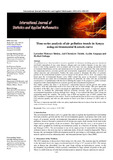| dc.contributor.author | Simiyu, L. M. | |
| dc.contributor.author | Chelule, J. C. | |
| dc.contributor.author | Ayubu, Anapapa O. | |
| dc.contributor.author | Imboga, H. | |
| dc.date.accessioned | 2021-04-29T12:02:37Z | |
| dc.date.available | 2021-04-29T12:02:37Z | |
| dc.date.issued | 2020-12 | |
| dc.identifier.citation | International Journal of Statistics and Applied Mathematics 2021; 6(1): 128-133 | en_US |
| dc.identifier.issn | 2456-1452 | |
| dc.identifier.uri | https://www.researchgate.net/publication/347700423_'TIME_SERIES_ANALYSIS_OF_AIR_POLLUTION_TRENDS_IN_KENYA_USING_ENVIRONMENTAL_KUZNETS_CURVE | |
| dc.identifier.uri | https://www.mathsjournal.com/pdf/2021/vol6issue1/PartB/5-6-13-659.pdf | |
| dc.identifier.uri | https://www.mathsjournal.com/archives/2021/vol6/issue1/PartB/5-6-13 | |
| dc.identifier.uri | https://www.semanticscholar.org/paper/Time-series-analysis-of-air-pollution-trends-in-Simiyu-Chelule/19cc2762efa6931fa8617caf285dab9cf223129d | |
| dc.identifier.uri | http://hdl.handle.net/123456789/4621 | |
| dc.description.abstract | Air pollution occurs when harmful or excessive quantities of substances including gases are introduced into Earth's atmosphere. It may cause diseases, allergies and even death to humans; it may also cause harm to other living organisms such as animals and food crops, and may damage the natural or built environment. Both human activity and natural processes can generate air pollution. The study analyzed the relationship between economic growth and environmental degradation with particular reference to carbon emissions and deforestation. Further, the study seemed to determine the effect of economic growth on the Environmental Kuznets Curve in Kenya for the period 1990 to 2018. The analysis was based upon the environmental Kuznets curve (EKC) model that posits an Inverted-U relationship between income per capita and environmental quality. In particular, the study took into account the current process of globalization with the aim of defining the impact of the progressive global economic integration on the relationship between economic growth and environmental degradation.
Past studies confirm that there is an Inverted-U relationship between income growth and carbon emissions, while the relationship result is less clear in the case of forest change. This goes against the hypothesis of the EKC, thus a need to investigate its applicability in the country. A regression analysis was done to establish the relationship between economic activities and per capita growth on environmental degradation in Kenya through forest change. It was realized that there exists a long-run relationship among the variables. The positive sign of GDP and negative sign of GDP2 confirms that EKC hypothesis is supported in the country. There is significant decrease in forest cover with increase in CO2 emission quantity and with one unit increase in forest cover there is decrease of 2.0074 units of CO2.
The study is important especially in the core policy implications that can be drawn from the results of the study in relation to climate change. | en_US |
| dc.language.iso | en | en_US |
| dc.subject | Time series analysis, GDP, EKC | en_US |
| dc.title | Time series analysis of air pollution trends in Kenya using environmental Kuznets curve | en_US |
| dc.type | Article | en_US |

